Chocolate’s secret ingredient – child slavery

Chocolate is a sweet business with disgusting ingredients – like child slavery. Attempts are being made to change the industry by pressing consumers, but Interpol says – free the children, prosecute the criminals.
Fifty-four children of seven different nationalities were rescued from plantations, and eight people were arrested in connection with the illegal recruitment of children during a two-day operation in Cote d’Ivoire, codenamed “BIA”.
Work conditions
Interpol says the plantation owners had bought the children, between ages 11 and 16, due to the need for cheap labor for harvesting. “They were discovered working under extreme conditions, forced to carry massive loads, seriously jeopardizing their health.”
These children were completely unaware of their rights or the fact that what was happening to them was illegal, Interpol reported. “They would regularly work 12 hours a day and receive no salary or education. Girls were usually purchased as housemaids and would work a seven-day week all year round, often in addition to their duties in the plantation.”
Cote d’Ivoire is the world’s largest cocoa producer. Add Ghana, Nigeria and Cameroon into the equation and West Africa is the world’s largest cocoa producing region. It is also a region whose foul record of forced labor has been repeatedly exposed and generally ignored.
“Perhaps the most dangerous task from the standpoint of health and safety,” reported the International Institute for Tropical Agriculture (IITA), “is the application of noxious pesticides.” Children are reportedly forced to work with dangerous chemicals and not provided with safety equipment.
They are also forced to use machetes. “An estimated 146,000 children under the age of 15 were clearing plantations using machetes…” the IITA said of their investigation.
Chocolate companies
Activists have pled with consumers to hold chocolate companies accountable. There have been exposés as well as pressure on companies to hold producers accountable, but the prevalence of child labor remains an unfortunate reality in chocolate.
Cocoa’s first consumers are chocolate companies, which could clean up the industry by refusing to buy beans produced by children.
The International Labor Rights Forum (ILRF) has a scorecard to assess the progress companies are making in their alleged efforts to stop exploiting child labor. It shows that if chocolate-makers had the same motivation to make chocolate as they are in fighting child slavery, the industry would have crumbled long ago.
Although the battle began in 2001, Hershey “continues to drag its feet in dealing with child and trafficked labor in its supply chain,” reports ILRF. “Like Mars and Nestle, Hershey has not effectively produced transparency or accountability…”
Nestle has been a main target of reformers because “unlike other chocolate manufacturers Nestle directly sources cocoa from West Africa and has direct control over its supply chain…” says ILRF.
Many other companies buy cocoa beans that include an assortment from non-African producers.
A hefty price tag doesn’t offer any assurance either. Even high-end chocolate retailer Godiva has not done much to clarify how they source their cocoa or the standards required of suppliers, according to their scorecard.
The illicit ingredient in chocolate is becoming less secret, but still producers appear confident enough that consumers will spend despite the negative publicity. Efforts to make retail consumers aware have resulted in a fair trade market.
Customers who purchase chocolate with the fair trade stamp are also supposed to receive peace of mind, knowing that the supply chain is being watched and regulated.
The enforcement approach
Interpol saved a small group, but it is believed that hundreds of thousands of children are still laboring away on cocoa plantations. Reports and internet campaigns aiming to break the link between child slavery and chocolate continue to circulate. However, enforcement could bring change much faster and more effectively.
BIA was Interpol’s first West African child trafficking operation, but it won’t be the last. Another operation is planned for later this year in Ghana.
Michelle Smith for RT













